I came across this excellent image by ‘Christos the Greek’ today and thought I would share it:
To see more of his images, click here.
Jay Smith
Some weeks ago now my Dad (Peter Smith) asked me if I fancied joining him and a bunch of other volunteers along with my brother, Aaron on a training session at the Netherfield Lagoons nature reserve in Nottinghamshire learning to use the scythe. Always looking for ways to expand my CV, I thought this would be an enjoyable way of spending a day in the open air involved in something very alien to the usual routines of life.
So, on the 22nd July, with my Grim Reaper outfit to hand I joined my Dad & my brother and headed over to the Lagoons, where we were soon joined by Raymond Lister and his partner, who were to be our tutors for the day. We proceeded in our vehicles along the lower path and parked outside the two green containers near to the River Trent.
The first task was to introduce Ray to the intended practice area for the day, so we headed up onto the bank between the Deep Pit and the Small Gravel Pit and looked down in the direction of the river onto the area of long grass below. At this point Ray began using some very worrying language, including terms such as ‘difficult going’ and ‘not for beginners’ each delivered with a general air of concern, leading Aaron and myself to wonder what exactly we’d let ourselves in for.
 The mood, however, was soon lightened by the appearance of Dave Gartside in the distance, who had just arrived at the rendezvous and set off in search of the rest of us, so we headed back to join him and await the arrival of the others. We did not have to wait long as Nigel Oram and Rob Woodward soon arrived to complete the group.
The mood, however, was soon lightened by the appearance of Dave Gartside in the distance, who had just arrived at the rendezvous and set off in search of the rest of us, so we headed back to join him and await the arrival of the others. We did not have to wait long as Nigel Oram and Rob Woodward soon arrived to complete the group.
Ray began the training with an introduction to the theory and equipment we were to employ during the day and into the future.
It seems that scything can be split into two very distinct applications, each dictates its own specific technique and equipment set-up.
‘Mowing’ is used to clear large and relatively flat areas of long or short grass and uses a long blade (around 85cm) with a very shallow profile sharpened to a very fine edge. The last millimetre or so at the edge of the blade is more like a foil and can be easily bent with the back of your thumbnail. A wide sweeping motion is employed, allowing you to clear a strip approximately 3m in width with each pass. Someone well experienced with the Scythe can clear an area 5m by 5m to a high standard in around a minute and a half using this technique.
‘Brush Cutting’ is used to clear areas of dense undergrowth and is much tougher than mowing. It employs much shorter strokes with a shorter blade (around 60cm) which has a deeper profile making it much more durable. The blade should also have what is called a ‘stone point’. A blunt tip that can impact hard objects without risking damage to the blade.
With Ray having talked about whetting, tangs, snaths, nips and beards I (and I suspect some of the others) was left somewhat bemused, and so was glad to enter a more practical phase to the day with a demonstration from Ray.
It was now that we learned the capabilities of the equipment we were to be using, which to my mind and in the context of today’s mechanised world by far exceeded what I had been expecting. Ray stepped into an area to the side of the containers and with an easy and relaxed action, swiftly cleared a sizeable area of brambles and undergrowth. ‘Combing’ down across the top of the undergrowth to make lengths of entangled bramble more manageable before under cutting the area in repetitive sweeps, inching forward and taking the undergrowth down to near ground level. It was an impressive example of what we were all about to inflict on the surrounding environment.
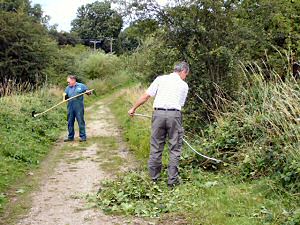
Emboldened by what we had just witnessed, it was now our turn and we each set off equipped with our own scythe to practice the techniques that had been the topic of the morning. It had been decided that we would work along the edges of the lower path, heading towards the car auction gates at the far end from where we were assembled. We each chose a spot and began to throw our enthusiasm at the undergrowth, each with varying levels of success.
At this point Jackie Dennison arrived and took some photos (which accompany this text) before helping by raking up after us for a while.
We carried on along the lower path until taking a hard earned break for lunch.
After lunch Ray started with some more theory. This time he discussed maintaining and sharpening the scythe, including ‘peening’ and edging the blade. Peening involves drawing out the edge of the blade using a hammer and small ‘bar peen anvil’ to achieve the desired profile before edging the blade using a whet stone. Different grades of whet stone coarseness are used to achieve the final edge.
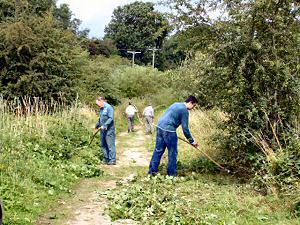
We then continued to make as much progress as we had time to along the lower path, taking the edges back by around a meter from the edge of the track, before the group headed back to camp, leaving Aaron and I to clear the debris of the group’s endeavours.
Thus concluded a very rewarding and educational day at the lagoons.
Further reading on this subject can be found at The Scythe Shop and www.scytheconnection.com.
Peter Smith
There has been a steady increase in warbler numbers at the lagoons as the vegetation has developed over the years. In 1996 the site was much more open, barren looking, with the Slurry Lagoon having only small reedy patches to relieve the blackness of the coal slurry. The bramble and hawthorn scrub patches were in their infancy and did not provide a deal of cover, with lots of bare earth still showing on the Deep Pit banks.
Nine species of warbler are regularly recorded breeding on the site, being Grasshopper Warbler, Sedge Warbler, Reed Warbler, Lesser Whitethroat, Whitethroat, Garden Warbler, Blackcap, Chiffchaff and Willow Warbler. Other species recorded are Cetti’s Warbler, Savi’s Warbler, Great Reed Warbler, Marsh Warbler, Dusky Warbler, Wood Warbler and Goldcrest, bringing the total species to sixteen, plus Scandinavian and Siberian races of the Chiffchaff. This is quite an impressive list for a 53-hectare site.
The 1999 Annual Report suggests a population of up to four pairs were occupying the site, mostly between the Large Gravel Pit and the Deep Pit bank but, as the bramble patches have developed, the territories now extend along all the slopes of the Deep Pit and along both sides of the Causeway as well as the area around the two Gravel Pits. The numbers have risen to a staggering eleven ‘reeling’ males this year. There was a dramatic drop in the middle of this period, which is not explained, with only one bird being recorded in 2003. A possible explanation could be that conditions in their wintering area in Africa could have been unsuitable due to drought.
Most Grasshopper Warbler breeding territories contain a large patch of brambles, some hawthorn scrub and coarse grass with umbellifers. The interface between the bramble and grasses is often the centre of the territory. The males rapidly set up a territory when they arrive on the site and start their reeling song to proclaim ownership of it. After about a week the females arrive and initiate peak male singing activity. There is a lot of chasing and courting as they settle in to the males’ territories and then, suddenly, life becomes much quieter with only one or two males reeling at a time.
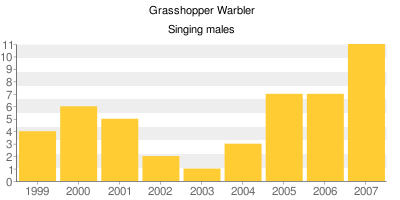
The nest is built on or near the ground in a hollow inside a tussock or other dense vegetation.
This has always been a common species at Netherfield and suggests their territories must be quite small to fit so many in such a small site. Their erratic song is a part of the summer sound of the lagoons. Like the Grasshopper Warbler they like brambles and scrub, but those chosen often border reeds or water. After the main arrival in spring there seems to be chattering song coming from almost every bush. There is also a dip in the Sedge Warbler’s numbers but this one occurred in 2005, when there was a drought in the Sahel, their wintering ground in Africa. Numbers now seem to be picking up and also suggest an upward trend.
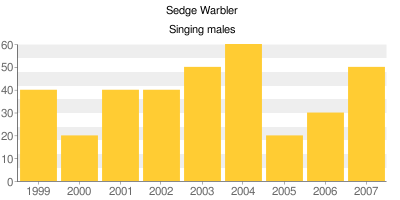
They like to build their nests in a wide variety of situations, sometimes suspended over water from several vertical stalks and sometimes on the ground under thick vegetation. Some nest well away from water and have recently started to use crops such as oil seed rape to build their nests in.
This species is almost completely dependent on the reed beds for breeding sites and, as the reed beds spread over the slurry and around the other pits, so their numbers increase. The first counts were in the region of fifteen birds but now counts are nearer twenty-five and their rhythmical songs fill the air as you walk around the Slurry Lagoon.
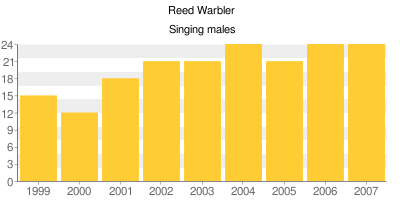
By far the commonest nest site is in a reed bed, suspended over the water by several reed stems. Even the small patches of reed in the deep pit can hold a breeding pair.
The preferred habitat for the Blackcap includes some mature trees and tall scrub, most of which can be found around the periphery of the site. There has been an increase in young ash trees growing around the site and some of the hawthorn scrub is quite tall, which seems to suit this warbler well. The male’s song is loud and richly musical and is generally given from the taller trees in its territory.
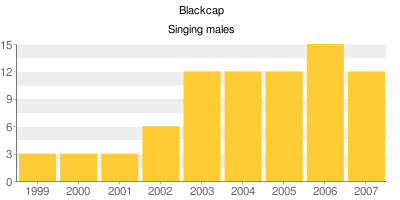
Blackcaps prefer to nest slightly higher off the ground than other warblers and may nest in a bush or on the low branch of a tree, up to eight feet from the ground.
As the tall, dense scrub on the slopes of the Deep and Slurry Pits develops, so does the favoured habitat of this species. When small gaps were made within these areas of scrub the Garden Warbler quickly moved in, showing this could be the way to increase their numbers further. The song is not as ‘fluty’ as the Blackcaps and is more ‘scratchy’ and sustained in its delivery.
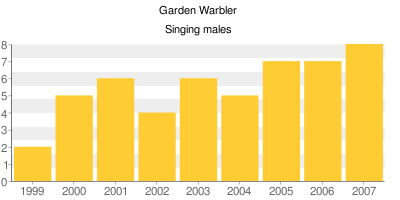
Nests are normally situated closer to the ground than the Blackcap’s, typically about a foot up in dense scrub, wedged in between supporting stems or twigs.
In 1999 there were only about two pairs in the area, but now there are more birds seen each spring and there are probably nearer to four pairs, with up to eight males passing through on passage. The habitat that tempts them to stay and breed is generally where brambles grow high up against a hedge or bush and the stems hang down from the top. The pair can spend the summer in there and, without the male’s rattled song; the world could be oblivious to them.
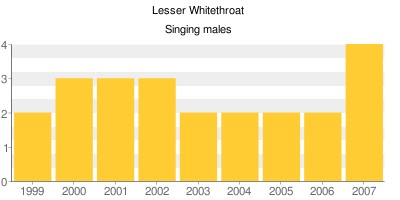
They prefer to build their nests in dense dark cover, normally a couple of feet above the ground, the dense bramble patches making an ideal site.
This is another warbler that is present in large numbers on the reserve and numbers have risen as the scrubby habitat they prefer has developed. They normally make their territories where they can find bushes for song posts that are about three metres high, surrounded by nettles and hemlock or cow parsley or other rank vegetation where they can hunt for insects. They often launch themselves into the air as they deliver their song.
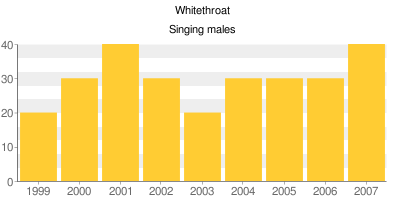
Normally the nest is built quite close to the ground in dense vegetation, but is sometimes higher in thick bushes.
The Chiffchaff prefers woodland with mature trees so we are quite lucky to have some on site. Their two-note song is sometimes performed from the power lines along the railway embankment. They are mainly along the railway line, riverbank and Boundary Hedge where the tallest trees grow, with a dense shrubby under-story. They are showing signs of increasing but two glitches, in 2002 and 2006, also show that they are still vulnerable to setbacks.
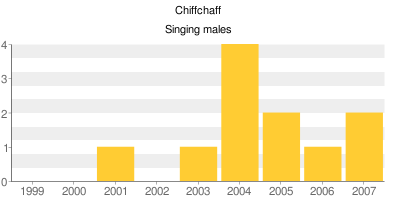
The Chiffchaff builds its domed nest close to or on the ground in rank vegetation or on a low branch, concealed by leaves.
This is another species that prefers scrub, but broken by some taller trees as well. Nationally the species is in decline but the site again manages to buck the trend and the gently descending notes of the song can be heard around most of the reserve.
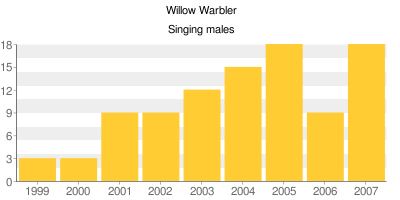
The nest is normally built on the ground or very close to it in thick cover of stems and leaves, and is domed, like the Chiffchaff’s, with an entrance towards the side.
As most of the warbler species nest on, or close to, the ground they are vulnerable to disturbance, especially by dogs, and the fences erected around the Slurry Lagoon and Deep Pit are probably also part of the reason for their recent success.
The downside to the increasing numbers of warblers is that the habitat that has developed and is encouraging them is replacing the bare muddy expanse that used to attract waders. There are just as many species of wader being recorded, as they follow the course of the river Trent and fly over the site, but not so many stop over and those noted are more likely to be individuals rather than the small groups that used to stop to feed and rest. The changes that seven years of colonisation by reeds, scrub and trees have made can be seen in the photographs reproduced as plates vii and viii. Unfortunately they were not all taken at the same time of year, but they do make the point.
Colin Harrison – A Field Guide to the Eggs, Nests and Nestlings of British and European Birds – Collins – 1975
Eric Simms – British Warblers – Collins / New Naturalist – 1985
The lagoons are a great place to start off the New Year, a refreshing walk to re-invigorate you after the holiday festivities will often be rewarded by some excellent birds. Entering the site from Teal Close you may see a flash of vivid blue as the Kingfisher zooms along the Ouse Dyke a little patience may gain you a view of this stunning bird perched along the bank. A Grey Wagtail is also often seen along the dyke, characteristically bobbing its tail and dashing along the muddy edges catching insects.
Commoner species such as Wren, Dunnock, Blackbird, Chaffinch, Blue Tit, Great Tit will be seen along the hedge often joined by a feeding party of Long-tailed Tits moving through giving their delightful contact calls whilst a Song Thrush is busy smashing snails on its ‘anvil’ under the bushes on the opposite bank.
Crossing over the footbridge on to the actual reserve take a moment to scan the fields, Pied Wagtails, Common Pheasant, Rook, Carrion Crow, Jackdaw will often be in evidence and you may also find Linnet, Yellowhammer, Lapwing, Grey Partridge and Mistle Thrush. Depending on the vegetation in the fields you may also encounter a small flock of Golden Plover hiding amongst the furrows, along with our Scandinavian winter visitors, Fieldfare & Redwing.
Around the footbridge is often a good place to see Bullfinches giving away their presence with their soft ‘phu’ calls. After climbing the steps of the slurry pit bank you should see and hear Redwings as they feed along the hedge bottoms and any Fieldfares flying over will announce themselves with their distinctive ‘schack-schack-schack’ calls. The slurry pit itself should hold good numbers of Teal, Shoveler, Gadwall, Pochard, Tufted Duck, Mallard, Coot and Moorhen with a few Little Grebe and maybe one or two Shelduck and Goldeneye. The apparently empty reed beds will actually hold several Reed Buntings which will flit down to the path edges as they feed. Along the water line, depending on the water level, you may see several Snipe as they roost or feed on the reed fringes.
A familiar sound at this time of year is the slightly alarming squeal of Water Rail which may be heard from any of the reed beds the best chances of seeing this secretive bird are when it flutters low across the water between reed beds or when it ventures out along more exposed shores to feed, especially in freezing conditions. These muddy edges may also attract waders such as Dunlin, Redshank, Common Sandpiper or Green Sandpiper.
The number of gulls on the slurry lagoon varies greatly depending on the time of day and the prevailing weather conditions. After early morning groups have dispersed many drift in and out during the day as they move into the adjacent farmland or further away to feed. Mid-afternoon often sees a gathering of gulls loafing around the lagoon. The most common species is Black-headed Gull with much smaller numbers of Common Gull. The large gulls are mainly Lesser Black-backed and Herring Gulls with smaller numbers of Great Black-backed Gulls, it is always worth searching the gull flocks as Iceland, Glaucous, Yellow-legged and Mediterranean Gull have all be recorded here in the winter months.
The Deep Pit will hold similar wildfowl species to those already encountered and Great Crested Grebes with probably have one or two Cormorants fishing whilst others rest and dry their wings on top of the nearby electricity pylon. The banks of the Deep Pit may hold a few wintering Meadow Pipit and an occasional Stonechat. Walking towards the railway bank you will invariably hear the ‘yaffle’ call of a Green Woodpecker and maybe see its lime-green back as it bounds away from you. If very lucky the explosive song of the Cetti’s Warbler may be heard but sightings are much more difficult to obtain.
The path along the railway bank is usually productive and sought after species such as Redpoll, Siskin and Willow Tit can often be seen with a little patience, the latter often visiting the bird table at the bottom of the bank near the signal box.
Both Pied and Grey Wagtails are often seen around the railway bridge and Stock Doves can be seen in the fields and on the wires across the river. The fields & river also have Canada & Greylag Geese, Wigeon and a few Grey Herons with the possibility of Redshank, Oystercatcher, Goldeneye or even a Goosander.
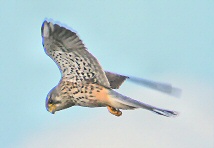
The Gravel Pits hold varying numbers of wildfowl but this is where you should see the highest numbers of Wigeon and careful searching of the Tufted Ducks may be rewarded with views of the occasional Scaup and Smew. Kestrels hunt over the grassy areas and Sparrowhawks may be encountered anywhere but especially along the hedges. A walk along the dense hedge between the fields and the gravel pits may reveal an over wintering Chiffchaff or even a Blackcap.
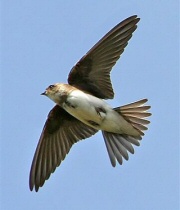
Spring is always a season of change as the leaves begin to unfurl, the first migrants and summer visitors are eagerly anticipated as the winter visitors start to drift away. Friendly competition drives the local patch regulars to spend more hours of the lengthening days in the field hoping to get the first record of the year for each species. Sand Martins are often the first to return with some passing thorough as early as the second week of March closely followed by the first early Swallows, these are often few in number and pass straight through on their journey north, the main arrival occurs in late March and early April.
Little Ringed Plovers start appearing from the third week in March and can be seen performing their aerial courtship displays throughout early spring. The warblers then start to arrive and mornings can become very noisy with Blackcap, Chiffchaff, Willow Warbler, Common Whitethroat, Sedge Warbler and Reed Warbler all singing heartily to attract a mate and declare their territory. A special treat at this time is to hear several Grasshopper Warblers delivering their reeling song from the scrub and bramble patches, before the leaves fully develop is the best time to catch a glimpse of these beautiful songsters.
The growing chorus is then joined by newly arrived Garden Warblers and Lesser Whitethroats, the latter often favouring the taller trees and bushes along the railway bank. The familiar call of the Cuckoo is heard, especially around the Deep Pit and the Gravel Pit, if you hear one search along the fence posts for the chance of a good sighting.
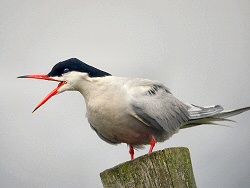
Yellow Wagtails will be found on the fields or the grass banks across the river and House Martins will be seen around the bridge as Swallows begin to nest under the bridge itself. Sand Martins begin nesting in the river bank and Common Terns will have returned to the nesting platforms on the Deep Pit.
By early May good numbers of Swifts can be seen feeding over and around the reserve and the Hobby will be putting in regular appearances as it hunts over the lagoons.
Spring is a great time to see more scarce birds pass through some are annual such as Northern Wheatear, Whinchat, Arctic Tern, Ringed Plover and Whimbrel. You may be fortunate to see some less frequent visitors such as Garganey, Marsh Harrier, Osprey, Black Tern, Little Gull and Common Redstart, anything is possible, as proven in May 2001 when a Little Swift spent 4 days feeding over the fields and lagoons and roosting overnight on the railway bridge.
After the hyper activity of spring things start to calm down as we move into the summer and breeding gets fully underway with the first fledglings appearing. The reserve is taken over by the beautiful summer flowers and their attendant butterflies, damselflies and dragonflies as the days become long and lazy.
Wader species that breed in the tundra regions start to occur on return passage as early as July which may be failed breeders or juvenile birds, these may include Dunlin, Green Sandpiper, Greenshank, Wood Sandpiper, Knot, and Curlew Sandpiper. The chances of seeing any of these stop over at the lagoons largely depends on the water levels and a fair degree of good luck.
The summer visitors disappear as migration gets underway with more waders such as Black-tailed Godwit, Bar-tailed Godwit and Ruff passing through along with warblers as they head south after breeding.
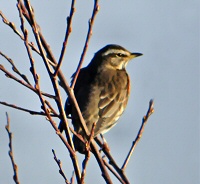
October sees the return of the first Redwings and Fieldfares which may also bring in one or two Brambling. Northern Wheatear, Whinchat, and Stonechat may be seen lingering for a few days and Siskins & Redpolls will arrive. The wildfowl numbers begin to build again and may include something a little more unusual such as a Pintail or Egyptian Goose, while careful sky watching could see the first flocks of Pink-footed Geese flying over or even a few Whooper Swans.
The rapidly shortening days and cold nights return as winter takes hold but there are still things to see at the lagoons as wildfowl numbers continue to grow, large concentrations of gulls form on the slurry lagoon and the fortunate visitor may catch sight of a Little Egret or even a Bittern before it disappears into the reed bed.
Several species of bird reached peak numbers this month, with Teal and Mallard reaching the one hundred mark and Gadwall reaching thirty. There were also twenty Cormorants, but a cold spell with frosts, mid-month, kept the Golden Plover numbers low. An adult winter Mediterranean Gull was a lucky find for one observer on the 5th.
As February warmed up the Golden Plover numbers rose too, reaching 1,000 by the middle of the month. The Gull numbers got higher too and a first winter Glaucous Gull roosted on the slurry lagoon on 14th, 21st and 22nd with the Herring and Greater Black-backed Gulls. Two Peregrines were present on the 21st (one had some primaries missing) and three Stonechats were around for most of the month. On 15th a lonely Brambling flew through.
At last some signs of spring with Ringed Plovers passing through and Lapwings displaying over the nearby fields. The first Chiffchaff arrived on the 8th while two Redwings seemed to be setting up a territory, with the male singing from the same bush for several days. On 1st of March a strange dark bird joined the Stonechats, its appearance suggesting a Pied Bushchat. Could it really have been one or just the result of the over active imagination of a poor deluded patch watcher?
On the 4th a Black-necked Grebe arrived for a prolonged visit, annoyingly leaving the evening before our first patch-watch on 28th. The first Wheatear was seen on the slurry lagoon, three weeks later than last years first bird. On the 11th a stunning male Red-breasted Merganser put in a brief appearance and the end of the month saw two male Ring Ouzles and our first ever Pied Flycatcher. The patch watch on 28th was coincidentaly a very good day for finding migrants, the early morning rain downing Ring Ouzle, Whinchat, Redstart and Wood Warbler and the afternoon sun and wind coaxing a Marsh Harrier and a Hobby to pay a visit.
The beginning of the month saw a lot of passage activity through the reserve with 57 Arctic Terns going through between 1st and 13th, joined by a Black Tern on 12th and 13th. A Nightingale took up residence near the railway line from 7th to 11th, singing almost continuously but not showing as it kept in deep cover. Morning showers on the 10th again did the business for migrant watchers and a “fall” occured over the slurry lagoon. Some of the birds recorded were, Grey Plover, Knot, 6 Sanderling, 5 Bar-tailed Godwits, 2 Whimbrel, 16 Curlew, Spotted Redshank, Green Sandpiper, 2 Turnstones and 11 Little Gulls. What could top this incredible day ? A Little Swift. On the morning of 25th an unusual swift was noticed over the slurry lagoon and identified as a Little Swift. Not only did the bird perform well for its thousands of admirers all day long, but it then went to roost on the railway bribge and spent an amazing three days on the site. The presence of so many birders for so long innevitably turned up more good birds and the site’s first Little Egret was seen as well as two or more Honey Buzzards and the first sighting of the long staying Argentine Blue-bill.
June could not match up to the excesses of May and was a very quiet month for birds. The orchids all flowered in their prescribed time slots and showed over all gains in numbers, even the Pyramidal Orchid doubling up.
Most of the birds were settled down and breeding and the sight of a Little Ringed Plover brooding three eggs was very heart warming. They were first noticed on the 6th and were hatched on 28th. On the 13th a batwatch was held, recording four species and also turning up the sites second record of a Little Egret, which attempted to roost with the gulls. Also noticed during the darker hours was the continual reeling of five Grasshopper Warblers. On the 30th a Red Kite was watched for twenty minutes over the slurry lagoon by one lucky observer.
Garganey and Spotted Redshank both put in a double appearance this month and a Black-necked Grebe also briefly reappeared. Merlin, Pintail and Spotted Flycatcher were also added to the sites species year list. There was also some interest amongst the gulls as a juvenile Mediterranean Gull spent some time on the slurry lagoon and a tentatively identified Caspian Gull was noted among the larger gulls.
A very early Whooper Swan was an unexpected find on the 8th and two other species of wildfowl broke site records this month. First the Grey-lag Goose flock topped 250 on the 8th and then 15 female pintail touched down on the slurry lagoon briefly on 29th. With the Pintail came other migrants as the autumn passage got under way.
The passage really took off during the first few days of the month with 865 Meadow Pipits being counted up until the 11th, the observer only counting for approximately one hour on each of the mornings, so very many more birds must have gone through. Over 100 Siskins were also counted passing over during this period. The month started well with an overnight gale bringing in a Grey Phalarope, which stayed from 1st to 4th and the Black Swan took up more pemanent residence and was joined by its mate between 3rd and 8th. There was a third visit from a Little Egret on the 17th and there were seven Common Scoter on 23rd. The month was topped off by another new species when three Bearded Tits were seen going through on 24th and 27th.
After so many good birds the year now started to wind down a little though a Merlin and a Jack Snipe on 4th provided one bright spot. The Golden Plover peaked this month on a dissapointing 2,000, but six Water Rail on 17th was a good count.
Cold December days were livened up by the presence of the Stonechats around the deep pit and occasional visits by a Peregrine. Common Gulls reached a high count of 80 on the 3rd, but the Common Snipe eclipsed that with 92 on the 16th rising to 200 by the 30th. On the 24th the Pochard/Tufted Duck hybrid returned to the site for its regular winter break.